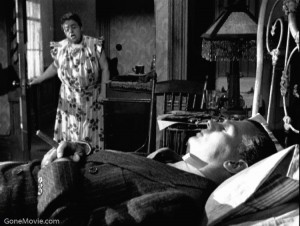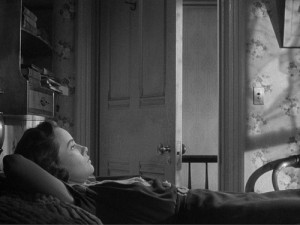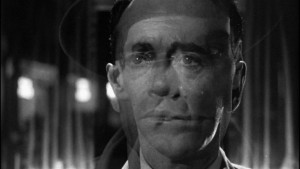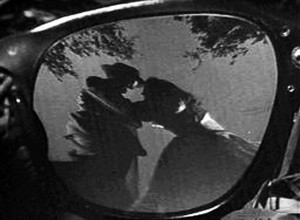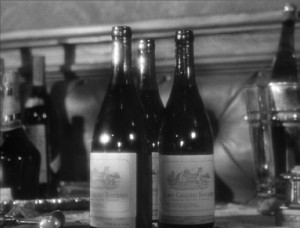Commissioned by Caboose Press for a forthcoming volume on Godard and posted here prematurely. — J.R.
François Truffaut
‘Un Trousseau de fausses clés’, Cahiers du Cinéma 39 (October 1954): 45–52.
I have often wondered why my favourite piece of film criticism by François Truffaut — ‘Un trousseau de fausses clés’, the final essay devoted to Alfred Hitchcock that appears in Cahiers du Cinéma No. 39, in October 1954, the first special issue of that magazine devoted to Hitchcock. — has never been included in any of Truffaut’s books. The likeliest reason is that Truffaut begins his article by responding to André Bazin’s essay in the same issue — pointedly called ‘Hitchcock contre Hitchcock’, maintaining that Hitchcock tended to tell his interviewers whatever they wanted to hear — by conceding that Hitchcock was something of a liar. Given Truffaut’s cordial relations with Hitchcock that ultimately led to his book-length interview with him, reprinting an essay that began with and then pondered the implications of such an assertion was something to be avoided.
Even so, the absence of this seminal essay from Truffaut’s ‘official’ critical oeuvre has been unfortunate, especially because it has obscured its importance as a major influence on Truffaut’s critical colleagues—most notably on Éric Rohmer and Claude Chabrol, in their pioneering 1957 book on Hitchcock, which alludes twice to this essay (without, however, providing a specific reference to it) and recapitulates much of its central analysis; on Jean-Luc Godard, in his own most ambitious and exhaustive critical analysis of a film, ‘Le Cinéma et son double’ (Cahiers du Cinéma issue no. 72 in June 1957), on Hitchcock’s The Wrong Man, which is even more indebted to Truffaut’s essay (although Godard never mentions it); and even, I would argue, on Jacques Rivette two decades later, not in any written criticism but in the découpage of his 1974 Céline et Julie vont en bateau.
The key discovery in Truffaut’s essay, its centrepiece, which formed part of the basis of Godard’s analysis of The Wrong Man, is the concept of ‘rhyming’ shots and the doubling of both characters and incidents in Shadow of a Doubt (1943), particularly in relation to the characters of young Charlie (Teresa Wright) and her Uncle Charlie (Joseph Cotten). Such a doubling is immediately apparent in the first glimpses we have of the two Charlies, but it is no less apparent in many of the subsequent details of the film. In his 1954 essay, Truffaut called this film ‘the second very important Hitchcock film’ (after Suspicion) and asserted that sixteen frame enlargements from the film could make his argument better than anything else, but, ‘because this is impossible’, an extended description of the film’s doublings would have to do (p. 48). This latter consists of (1 and 3) descriptions of the first shots of Uncle Charlie and Charlie, (2) an account of two men looking for Uncle Charlie, (4) an account of Charlie returning from having sent a telegram to her Uncle Charlie, inviting him to come for an extended visit, only to discover that Uncle Charlie has quite independently just sent her family a telegram announcing his arrival. . . .
This sort of doubling is Truffaut’s. And Godard’s adherence to the basis of this analysis extends even to episode 4A of his 1998 Histoire(s) du cinéma, a formal structure that Hitchcock returned to more than once — most obviously in his final film, Family Plot (1976), which oscillates between the separate but eventually intersecting stories of two couples, one working class (Barbara Harris and Bruce Dern) and the other one upper class (Karen Black and William Devane), and Godard’s tracing of this structure through The Wrong Man is signalled even in his article’s title, a punning allusion to Antonin Artaud’s Le Théâtre et son double. His argument, echoing Truffaut’s fourteen-part summary of the doublings in Shadow of a Doubt, is mostly contained in a single paragraph and a footnote to the former’s first sentence which read successively as follows (in Tom Milne’s English translation):
Each crucial scene in The Wrong Man has in effect its respondent, its ‘double’, which justifies it on the narrative level while at the same time ‘redoubling’ its intensity on the dramatic level.* Rose’s burst of laughter echoes that of the little girls who now live in the apartment belonging to one of the missing witnesses. The domestic scene where she hits Balestrero is the double — the negative — of the one at the beginning of the film in which she jokingly expresses mild doubts about the possibility of their being happy in this world.
* To cite at random: the two imprisonments; the two handwriting tests at the police-station; two conversations with Rose in the kitchen; the two hearings; apart from the credit sequence, the Stork Club appears twice; Manny goes twice to the clinic, twice to the lawyer, twice with the two policemen into two shops for identification; the spy-hole [in prison] duplicating the driving-mirror; the insurance company is in the same building as the lawyer’s office; the two miracles happening on [Henry] Fonda’s face; Bernard Herrmann’s score is based on two notes, etc.
To a greater extent than Truffaut’s lengthier analysis, some of Godard’s examples seem willful and forced (e.g., the Stork Club, Herrmann’s score). But his overall postulate of a consistent formal pattern on Hitchcock’s part is no less persuasive than which focuses on Hitchcock, when Godard includes one of the two (alleged) ‘miracles happening on Fonda’s face’.
As I discovered when I interviewed Godard about Histoire(s) du cinéma in September 1996, he has persisted in regarding this episode, invented by Hitchcock, as a real-life ‘miracle’ in Balestfero’s life, and wasn’t interested in hearing any of the evidence disputing this belief. In section 4A of Histoire(s) du cinéma, in a segment entitled ‘Introduction to Alfred Hitchcock’s Method’, a series of intertitles thereby dubs Hitchcock ‘the only one apart from Dreyer who knew how to film a miracle’. But it is worth adding that, even though most of Histoire[s] du cinéma treats Godard’s criticism of the 1950s as part of film history and therefore as something fixed and not subject to amendments or dispute, the primary critical point about Hitchcock in episode 4A — that he was a poète maudite of objects (by implication a blood brother of someone like Francis Ponge, albeit one who addressed a massive public) — seems to contradict or at least challenge the implication of his earlier analysis that Godard was more a narrative artist.
Although it would be excessive to credit Truffaut’s essay with inaugurating the discussions of ‘exchange’ and ‘transfer of guilt’ that animate the earliest serious Hitchcock criticism, there is little doubt that its treatment of doubling offered a formal basis for many of those thematic discussions. And Godard was one of the clearest beneficiaries of this insight.
Jonathan Rosenbaum
Jean-Luc Godard. ‘The Wrong Man’ (1957), in Godard on Godard, eds. Jean Narboni and Tom Milne, trans. Milne (New York: Da Capo, 1986 [1972]), 48–55.
———. Histoire(s) du cinéma, 4 vols. (Paris: Gallimard/Gaumont, 1998).

